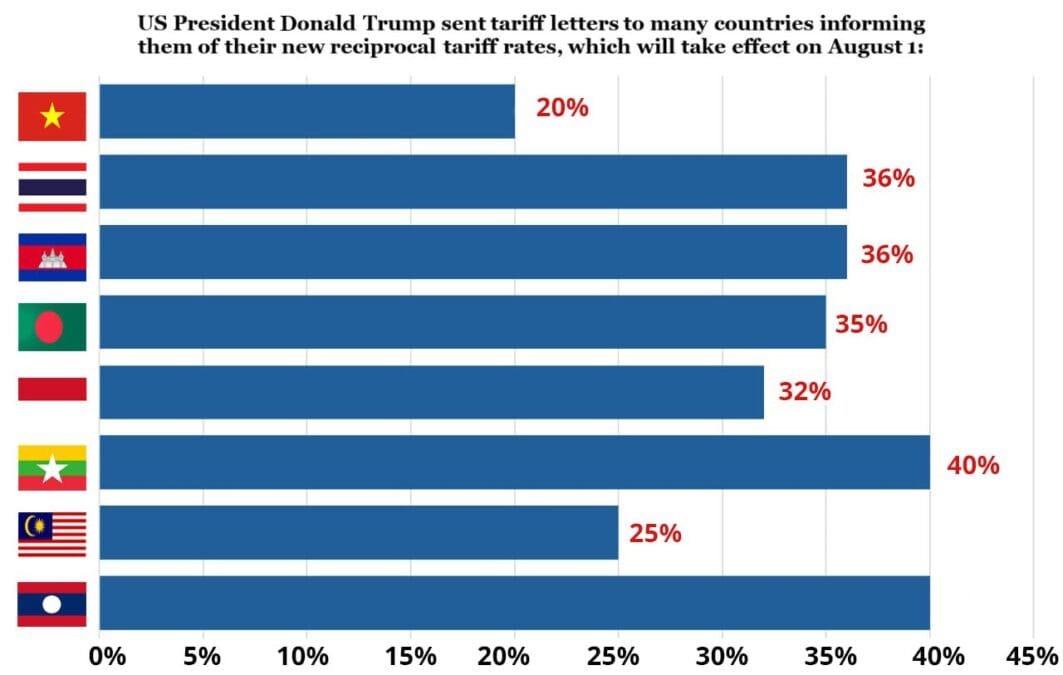Cambodia has successfully secured a crucial deal with the United States to avoid a potentially devastating 49% tariff hike, marking a significant win for the country’s export-driven economy. This strategic move, described as a major example of Cambodia Export Tariff Avoidance, helps protect millions of livelihoods and preserve market access for one of its most important trading partners.
A Threat to $7 Billion in Exports
In 2024, the US accounted for about 38% of Cambodia’s total exports, valued at roughly $9.9 billion. The proposed 49% tariff, though later reduced to 36%, posed a serious risk to nearly $7 billion worth of goods—primarily garments, footwear, and travel goods. The garment sector alone employs around 800,000 workers, making it the backbone of Cambodia’s manufacturing industry and a critical source of income for many families.
Without Cambodia Export Tariff Avoidance strategies, the impact on workers and the economy could have been severe, potentially resulting in mass layoffs and factory closures.
Cambodia Export Tariff Avoidance: Negotiating to Reduce the Tariff

To avoid the steepest tariff in ASEAN, Cambodia took decisive action. The government negotiated with US officials to bring the tariff rate down from the initially proposed 49% to 36%. In return, Cambodia agreed to slash its import tariffs on 19 categories of US goods from 35% to just 5%.
This bold move not only reduced immediate financial pressures but also demonstrated Cambodia’s willingness to de-escalate trade tensions and maintain strong bilateral relations. By prioritizing this, the country preserved access to its most valuable export market and safeguarded countless jobs.
Diversifying Through Regional Trade Agreements
While the US remains vital, Cambodia is also focusing on diversifying its export markets to reduce future risks. In 2024, Cambodia’s exports to Regional Comprehensive Economic Partnership (RCEP) member countries reached $34.52 billion, a 17.7% year-on-year increase.
In the first ten months of 2023, exports to RCEP nations grew by over 25% compared to the same period in 2022, driven by strong demand from key partners like China and Japan. Additionally, the Cambodia-China Free Trade Agreement (CCFTA) has strengthened market access and helped the country shift more exports toward Asia.
Read Also: Rising Hopes in Cambodia Agricultural Export Opportunities
By expanding trade relationships, Cambodia demonstrates proactive tariff avoidance strategies, ensuring that its economy remains resilient even in the face of global trade challenges.
Protecting Jobs and Strengthening the Economy
The combination of securing a lower US tariff and increasing regional exports supports Cambodia’s goal of sustaining export growth and protecting jobs. The garment sector’s survival is vital not only for economic stability but also for social welfare, as it supports millions of Cambodian families.
The country’s quick response to tariff threats shows a commitment to keeping its manufacturing sector strong and competitive. Through careful negotiation and smart trade policies, Cambodia is reinforcing its position as a reliable global exporter.
Read Also: The Untold Impact of Cambodia Infrastructure Connectivity
Looking Ahead: Cambodia Export Tariff Avoidance
For its neighboring countries, Cambodia’s experience offers a powerful example of how strategic trade negotiations and diversification can protect national interests. With a strong focus on both preserving access to the US market and expanding regional ties, Cambodia is well-positioned to maintain momentum and build a more resilient, diversified export economy in the years to come.
By successfully implementing Cambodia Export Tariff Avoidance measures, the country has avoided economic setbacks and secured a path for continued growth.
